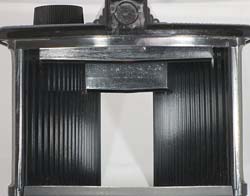Ilford Envoy
Specification

| Manufacturer | : | Ilford |
|---|---|---|
| Produced | : | 1953 - 1960 |
| Classification | : | Medium Format |
| Body Type | : | Solid Body |
| Construction | : | Bakelite |
| Film Type | : | 120/620 |
| Film Width | : | 62mm |
| ImageSize | : | 2¼ x 3¼ in |
| No. of Images | : | 8 |
| Lens Type | : | Ilford Optimax |
| Focal Length | : | 90mm |
| Focus Type | : | Two Position |
| Focal Range | : | 4ft - inf. |
| Aperture Type | : | Fixed |
| Aperture | : | f/16 |
| Shutter Type | : | Rotary |
| Shutter Speeds | : | T, I*(1/40sec) |
| Size (w x h x d) | : | 112 x 95 x 105 mm |
| Weight | : | 370g |
| * Measured on this camera | ||
Art Deco Credentials
![]()
![]()
![]()
Noteworthy: Worth giving special attention
- Designed after the main Art Deco period
- Bakelite body with linear raised pattern surrounding camera
- Body embossed with leather style surface
- Optical finder with stepped linear ornamentation
- Rounded trapizoidal shape
Description
The Ilford Envoy is a Bakelite box camera which was sold by Ilford from c.1953-1960. The Envoy was made in Birmingham, UK for Ilford by Photo Developments Ltd. There are three styles. The first has a black lens surround and black film advance knob, the second had an aluminium surround and the third (1955 shown above) had a side-mounted carry strap. Later models had an aluminium film advance knob. The camera shows the influence of the Streamline Moderne era with its horizontal lines and rounded corners.

The deficiencies of the cheap lens is compensated somewhat by a curved film plane. The camera can take both 620 and 120 film spools. To load the film, rotate a key in the base and remove the top. The top carries the spools and film guides, the bottom has the shutter and lens.
The glossy plastic construction would be likely to cause internal reflections and degrade the image quality, so the light path is baffled by ribbing of the side walls of the film chamber. A downward plastic projection provides baffling to the top of the film chamber, while the bottom of the chamber is a metal plate, painted matt black.
The simple, single-speed shutter is synchronised for flash, with two contacts below the lens for the flashgun connection. Model 3 uses a classic DIN standard 3 mm socket for the flash connector. The lens has two focus zones and is marked 'FOR FACES · PULL OUT + FOR PLACES · PUSH IN'. 'FACES' covers 4ft-8ft and 'PLACES' 8ft-infinity. The shutter actuator is found on the top of the camera.
How to Use
If you don't want to bother with an exposure meter, follow the guide shown. It is based on the 'Sunny 16' rule. Film is so forgiving and will produce acceptable results even when overexposed by 2 or 3 stops or underexposed by 1 stop.
Remember that the exposure guide in the camera user manual may not be helpful as it is based on the use of old film with a low ISO value.
The table assumes that the sun is at least 30 degrees above the horizon - that's 10am - 5pm on a summer's day (May-August) in the UK.
This camera has an aperture of f/16 and a shutter speed is 1/40s.
As the shutter speed is only 1/40s, it is advisable to try to hold the camera against a wall or other solid object. For quick snapshots, hold it firmly against your face.
Using ISO 100/125 film - shutter speed 1/40s
| Weather Conditions | Shadow Detail | Aperture | Exposure |
|---|---|---|---|
 Sunny SunnySnow/Sand | Dark with sharp edges | f/16 | +2 Stop Overexposed Acceptable |
 Sunny Sunny | Distinct | f/16 | +1 Stop Overexposed Acceptable |
 Slight Overcast Slight Overcast | Soft around edges | f/16 | Good |
 Overcast Overcast | Barely visible | f/16 | -1 Stop Underexposed Acceptable |
 Heavy Overcast Heavy Overcast | None | f/16 | -2 Stop Underexposed Unacceptable |
 Open Shade Open Shade/Sunset | None | f/16 | -3 Stop Underexposed Unacceptable |